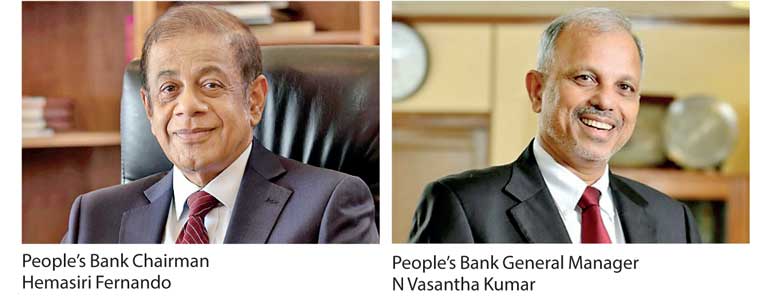Monday Mar 10, 2025
Monday Mar 10, 2025
Friday, 9 June 2017 00:00 - - {{hitsCtrl.values.hits}}

By Uditha Jayasinghe
Sri Lanka’s second-largest bank, People’s Bank, is to get a capital infusion of Rs. 5 billion after the lapse of nine years, as the Government steps up efforts to assist it to meet international Basel III standards.
The move, which received Cabinet approval this week, is expected to bridge the current regulatory capital shortfall to meet the new requirements that are in excess of Rs. 20 billion over the next three years. The Cabinet paper, which was presented by Public Enterprise Development Minister Kabir Hashim, details that the bank has assets of Rs. 1.4 trillion and a lending portfolio of over Rs. 1 trillion.
People’s Bank has traditionally been a key lender to the State and state-owned enterprises (SOEs) with a third of the total loan book composed of lending to SOE’s.
The bank is also among the largest contributors to the Government in taxes, including Value Added Tax, with a total of Rs. 20.5 billion paid in 2016 alone. Aggregate contribution made over the preceding 10-year period was Rs. 117.6 billion. The Cabinet Paper also cites the bank’s position as one of the largest lenders to the country’s SME segment amongst Licensed Commercial Banks.
In addition, it has also paid a total of Rs. 34.9 billion in dividends to the Government since 2008.
“Recently, Cabinet approved to amend the People’s Bank Act and this is a big plus as it will offer the bank better flexibility for recapitalisation and the issuance of new debentures - including for the purposes of bolstering the bank’s regulatory capital levels as and when needed,” CEO/GM Vasantha Kumar said in the latest annual report of the bank.
As at end-2016, the Bank’s Tier I and overall Capital Adequacy Ratio (CAR) declined slightly to 9.8% and 12.1% respectively as compared with 9.9% and 12.6% at end-2015 despite strong portfolio growth. The Central Bank requirement is Tier 1 of not less than 5% and CAR of not less than 10%.
Implementation of BASEL 3 minimum capital requirements and leverage ratio frameworks will come into effect on 1 July 2017. The bank is geared to embrace these proposed changes in contributing towards a more resilient banking industry, it added in the annual report.
As a fully Stated-owned entity, the bank has no access to the equity markets and due to the stipulations of the People’s Bank Act access to the debt market is also limited. As such the bank must rely entirely on its own capital generation and infusions from the Government Treasury to augment its capital base in funding future growth.
The bank has reached an informal agreement with the Government Treasury to limit the bank’s dividend payouts to the extent that the bank’s Tier 1 CAR does not fall below 6.5% on a regulatory basis and 6% as per the bank’s internal computations. The bank also strives to maintain a total CAR of not less than 12% (regulatory basis). Going forward the bank has made necessary arrangements with regard to a robust capital augmentation plan to ensure BASEL 3 compliance when it comes into effect on 1 July 2017.
Fitch Ratings, in its latest report on banks, warned that capitalisation was thin at state banks due to substantial dividend payouts. In 2016, the three largest state banks - National Savings Bank, Bank of Ceylon and People’s Bank (Sri Lanka) - paid 76% of their profits as dividends. Their capital levels are vulnerable to dividend demands from the State, and continued high payouts in the absence of capital infusions could leave them struggling to meet regulatory capital requirements.
“Rapid loan growth by private banks exceeding their rate of internal capital generation has weakened capital ratios. The sector’s average Tier 1 capital ratio declined to 11.4% at end-2016 from 13.0% at end-2015, following high loan growth of 21.1% and 17.5% in 2015 and 2016 respectively, despite several contractionary monetary policy measures,” the ratings agency added.
Discover Kapruka, the leading online shopping platform in Sri Lanka, where you can conveniently send Gifts and Flowers to your loved ones for any event including Valentine ’s Day. Explore a wide range of popular Shopping Categories on Kapruka, including Toys, Groceries, Electronics, Birthday Cakes, Fruits, Chocolates, Flower Bouquets, Clothing, Watches, Lingerie, Gift Sets and Jewellery. Also if you’re interested in selling with Kapruka, Partner Central by Kapruka is the best solution to start with. Moreover, through Kapruka Global Shop, you can also enjoy the convenience of purchasing products from renowned platforms like Amazon and eBay and have them delivered to Sri Lanka.
Discover Kapruka, the leading online shopping platform in Sri Lanka, where you can conveniently send Gifts and Flowers to your loved ones for any event including Valentine ’s Day. Explore a wide range of popular Shopping Categories on Kapruka, including Toys, Groceries, Electronics, Birthday Cakes, Fruits, Chocolates, Flower Bouquets, Clothing, Watches, Lingerie, Gift Sets and Jewellery. Also if you’re interested in selling with Kapruka, Partner Central by Kapruka is the best solution to start with. Moreover, through Kapruka Global Shop, you can also enjoy the convenience of purchasing products from renowned platforms like Amazon and eBay and have them delivered to Sri Lanka.